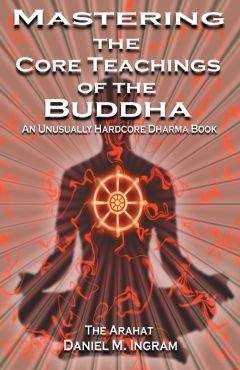While Theravada Buddhism clearly states how to obtain the
“psychic powers,” it does not say much about how to use them, the benefits of them, or their dangers. Tantra and many other traditions (such as some of the shamanic traditions) do a much better job of dealing with these. One might also check out the later writings of Carlos Castanada when he was not so fascinated with hallucinogens (such as The Art of Dreaming), go to an ashram that focuses on these aspects of spiritual training, or check out traditions such as Ceremonial Magick, Wicca, Thelema, the Golden Dawn, and the A.’.A.’..
149
The Concentration States (Samatha Jhanas)
Note, I will use the word magick with a “k” at times due to being influenced by this and related traditions, as they advocate making a distinction between show magic (illusions based on mechanisms and slight of hand) and the territory of the powers or real magick. Donald Michael Kraig’s Modern Magick is a classic on the subject, as are the works of Aleister Crowley. Opinions on Crowley vary widely, but buried in his frustrating works is gold that is hard to find elsewhere. Despite all his quirks and failings, I have a deep appreciation for many synchretic aspects of his work and the depths of his dedication to making meditation and magick accessible.
It is also possible to use the experiences of the psychic powers, particularly the visions and traveling out of body, as a basis for insight practice by the standard method of bare sensate investigation with a focus on the Three Characteristics of those sensations, as they arise out of extremely high levels of clarity and concentration. These experiences can also be so otherworldly in content that our normal fixations and preoccupations may be left behind. Experiences of insight in these realms can be staggering and awesome. They are not soon forgotten.
Tantric visualization practices at their best make powerful use of this fact. By definition, if you have visualized a 3D intelligent entity that is doing its own thing, you are in strong concentration in the fourth jhana and it is just a question of seeing the Three Characteristics of that to get some serious insight.
“Psychic powers” can also arise spontaneously from insight practice, particularly at stage 4. The Arising and Passing Away and sometimes at stage 11. Equanimity (see The Progress of Insight later). While the fourth jhana is traditionally said to be the basis for the psychic powers, simply getting so strongly into the first jhana that you can no longer perceive a body coupled with the previous intention to have these experiences can sometimes be a sufficient to make them occur. Get really into the jhana, leave it, resolve to have these experiences, and see what happens. Repeat as necessary. If that doesn’t work, learn to visualize the colors white, blue, red and yellow clearly as stable experiences and then repeat the above instruction. If that doesn’t work, find the rare teacher who will actually guide you into this esoteric territory. Better, find a good teacher before getting into this territory!
150
The Concentration States (Samatha Jhanas)
If all of that is not enough, here is my best advice for working with the powers formally. Once you have enough concentration to get into hard fourth jhana with a range of objects and colors, here’s traditional Buddhist Magick 101 with some practical points thrown in:
1. Make the bases clean, meaning bathe quietly and put on clean clothes. This instruction helps but is not necessary.
2. Find a suitable place to work, meaning a place that is quiet and free of distractions. If you can’t find such a place or you feel compelled to do magick in less than optimal circumstances
(such as in public on the fly), obviously skip this step.
3. Think the whole thing through before you proceed. Never, ever skip this step if you can possibly help it. This step not only helps to keep you from seriously screwing up, it is actually part of the spell and a very important part of the set-up. Essential things to include are:
a. what you are asking for,
b. how to phrase it or intend it, being as specific as you
possibly can,
c. why you are asking for that, particularly if there is some more fundamental desire you hope to fulfill that you
should focus on while letting the less important specifics
happen as they may,
d. exactly who or what is involved,
e. and every single possible good and bad ramification of
what you are about to do that you can possibly think of.
Really take your time with this one, visualizing the whole
thing out in time and space as far as it could possibly go.
f. Note: if the ethics of what you are going to do feel at all strange in any part of your being, particularly your heart
or gut, you probably need to go back up to the top and
rethink the whole thing while looking at the problem
from other points of view.
4. Rise from the first to the fourth jhana. Build each one up carefully and fully along the way so that you have a good
foundation from which to work. Those who can access the
formless realms (discussed shortly) might rise all the way
151
The Concentration States (Samatha Jhanas)
through them as well. Then leave the fourth (or eighth) jhana and formally intend to make whatever you want to occur
happen, which is to say let the full energy of your intention fly without hesitation or restraint. If you are going to do this, make sure you commit to it, which is why the third step is so
important.
5. Let it go and see what happens.
One last warning on the powers: doing these things in the private is one thing, doing magickal things in public that involve other people is something else entirely. If you do overt public magick or discrete public magick, you are bound to run into someone else’s paradigms, values, and sets of beliefs about how the world is and what is possible that are not in alignment with your own. The potential for bad reactions from others is very real for a large number of reasons. Consider the long, strange relationship between the Western mainstream point of view and everything from witchcraft to crime solving psychics. In short, if you do formal magick and anyone else finds out about it or thinks they were affected by it, be ready for the possibility of serious backlash and fallout.
The formless realms are the last option one can follow from the fourth jhana, and they can definitely be very useful for putting things into perspective and sorting out a few details about “awareness” (as will be mentioned below). Before I go into the formless realms, I will digress for just a moment to a brief and belated discussion of...
152
Mastering the Core Teachings of the Buddha
22.NO-SELF VS. TRUE SELF
This is one of those questions that tends to arise when Hinduism or Christianity come in contact with Buddhism. However, perhaps it should arise more when Buddhism is thinking about itself. I include this discussion here because it addresses some points that are useful for later and previous discussions. True Self and no-self are actually talking about the same thing, just from different perspectives. Each can be useful, but each is an extreme. Truly, the truth is a Middle Way between these and is indescribable, but I will try to explain it anyway in the hope that it may support actual practice. It may seem odd to put a chapter that deals with the fruits of insight practices in the middle of descriptions of the samatha jhanas, but hopefully when you read the next chapter you will understand why it falls where it does.
For all you intellectuals out there, the way in which this chapter is most likely to support practice is to be completely incomprehensible and thus useless. Ironically, I have tried to make this chapter very clear, and in doing so have crafted a mess of paradoxes. In one of his plays, Shakespeare puts philosophers on par with lawyers. In terms of insight practice, a lawyer who is terrible at insight practices but tries to do them anyway is vastly superior to a world-class philosopher who is merely an intellectual master of this theory but practices not at all.
Remember that the spiritual life is something you do and hopefully understand but not some doctrine to believe. Those of you who are interested in the formal Buddhist dogmatic anti-dogma should check out the particularly profound suttas, #1, The Root of All Things, in The Middle Length Discourses of the Buddha, as well as sutta #1, The Supreme Net (What the Teaching is Not), in The Long Discourses of the Buddha.
Again, realize that all of this language is basically useless in the end and prone to not making much sense. Only examination of our reality will help us to actually directly understand this, but it will not be in a way accessible to the rational mind. Nothing in the content of our thoughts can really explain the experience of the understanding I am about to point to, though there is something in the direct experience of those thoughts that might reveal it. Everything that I am about to try to explain
No-self vs. True Self
here can become a great entangling net of useless views without direct insight.
Many of the juvenile and tedious disputes between the various insight traditions result from fixation on these concepts and inappropriate adherence to only one side of these apparent paradoxes.
Not surprisingly, these disputes between insight traditions generally arise from those with little or no insight. One clear mark of the development of true insight is that these paradoxes lose their power to confuse and obscure. They become tools for balanced inquiry and instruction, beautiful poetry, intimations of the heart of the spiritual life and of one’s own direct and non-conceptual experience of it.
No-self teachings directly counter the sense that there is a separate watcher, and that this watcher is an “I” that is in control, observing reality or subject to the tribulations of the world. Truly, this is a useful illusion to counter. However, if misunderstood, this teaching can produce a shadow side that reeks of nihilism, disengagement with life and denial. People can get all fixated on eliminating a “self,” when the emphasis is supposed to be on the words “separate” and “permanent,”
as well as on the illusion that is being creating. A better way to say this would be, “stopping the process of mentally creating the illusion of a separate self from sensations that are inherently non-dual, utterly transient and thus empty of any separate, permanent self.”
Even if you get extremely enlightened, you will still be here from a conventional point of view, but you will also be just an interdependent and intimate part of this utterly transient universe, just as you actually always have been. The huge and yet subtle difference is that this will be known directly and clearly. The language “eliminating your ego” is similarly misunderstood most of the time.
You see, there are physical phenomena and mental phenomena, as well as the “consciousness” or mental echo of these, which is also in the category of mental phenomena. These are just phenomena, and all phenomena are not a permanent, separate self, as they all change and are all intimately interdependent. They are simply “aware,” i.e. manifest, where they are without any observer of them at all. The boundaries that seem to differentiate self from not-self are arbitrary and conceptual, i.e.
154
No-self vs. True Self
not the true nature of things. Said another way, reality is intimately interdependent and non-dual, like a great ocean.
There is also “awareness”, but awareness is not a thing or localized in a particular place, so to even say “there is also awareness” is already a tremendous problem, as it implies separateness and existence where none can be found. To be really philosophically correct about it, borrowing heavily from Nagarjuna, awareness cannot be said to fit any of the following descriptions: that it exists, that it does not exist, that it both exists and does not exist, that it neither exists nor doesn’t exist. Just so, in truth, it cannot be said that: we are awareness, that we are not awareness, that we are both awareness and not awareness, or even that we are neither awareness nor not awareness. We could go through the same pattern with whether or not phenomena are intrinsically luminous.
For the sake of discussion, and in keeping with standard Buddhist thought, awareness is permanent and unchanging. It is also said that,
“All things arise from it, and all things return to it,” though again this implies a false certainty about something which is actually impenetrably mysterious and mixing the concept of infinite potential with awareness is a notoriously dangerous business. We could call it “God,” “Nirvana,”
“The Tao,” “The Void,” “Allah,” “Krishna,” “Intrinsic Luminosity,”
“Buddha Nature,” “Buddha,” “Bubba” or just “awareness” as long as we realize the above caveats, especially that it is not a thing or localized in any particular place and has no definable qualities. Awareness is sometimes conceptualized as pervading all of this while not being all of this, and sometimes conceptualized as being inherent in all of this while not being anything in particular. Neither is quite true, though both perspectives can be useful.
If you find yourself adopting any fixed idea about what we are calling
“awareness” here, try also adopting its logical opposite to try to achieve some sense of direct inquisitive paradoxical imbalance that shakes fixed views about this stuff and points to something beyond these limited concepts. This is incredibly useful advice for dealing with all teachings about “Ultimate Reality.” I would also recommend looking into the true nature of the sensations that make up philosophical speculation and all sensations of questioning.
155
No-self vs. True Self
While phenomena are in flux from their arising to their passing, there is awareness of them. Thus, awareness is not these objects, as it is not a thing, nor is it separate from these objects, as there would be no experience if this were so. By examining our reality just as it is, we may come to understand this.
Further, phenomena do not exist in the sense of abiding in a fixed way for any length of time, and thus are utterly transitory, and yet the laws that govern the functioning of this utter transience hold. That phenomena do not exist does not mean that there is not a reality, but that this reality is completely inconstant, except for awareness, which is not a thing. This makes no sense to the rational mind, but that is how it is with this stuff.
One teaching that comes out of the Theravada that can be helpful is that there are Three Ultimate Dharmas or ultimate aspects of reality: materiali ty (the sensations of the first five sense doors), mentalit y (all mental sensations) and Ni rvana (though they would call it “Nibbana,”
which is the Pali equivalent of the Sanskrit). In short, this is actually it, and “that” which is beyond this is also it. Notice that “awareness” is definitely not on this list. It might be conceptualized as being all three (from a True Self point of view), or quickly discarded as being a useless concept that solidifies a sense of a separate or localized “watcher” (from the no-self point of view).





